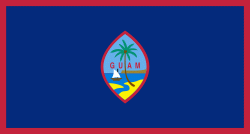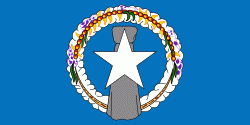Chamorro language
Chamorro (Finuʼ Chamorro (CNMI), Finoʼ CHamoru (Guam) ) is an Austronesian language spoken by about 58,000 people (about 25,800 people on Guam and about 32,200 in the rest of the Mariana Islands and elsewhere). It is the native and spoken language of the Chamorro people, the indigenous people of the Marianas (Guam and the Commonwealth of the Northern Mariana Islands. Guam is a US territory while the CNMI has greater autonomy as a US commonwealth). There are three different dialects of Chamorro — Guamanian, Rotanese, and the general NMI (Saipan and Tinian) dialects.
Unlike most of its neighbors, Chamorro is not classified as a Micronesian or Polynesian language. Rather, like Palauan, it possibly constitutes an independent branch of the Malayo-Polynesian language family.
At the time the Spanish rule over Guam ended, it was thought that Chamorro was a semi-creole language, with a substantial amount of the vocabulary of Spanish origin and beginning to have a high level of mutual intelligibility with Spanish. It is reported that even in the early 1920s, Spanish was reported to be a living language in Guam for commercial transactions, but the use of Spanish and Chamorro was rapidly declining as a result of English pressure.
Spanish influences in Chamorro exist due to three centuries of Spanish colonial rule. Many words in the Chamorro lexicon are of Latin etymological origin via Spanish, but the pronunciation of these loanwords has been nativized to the phonology of Chamorro, and their use conforms to indigenous grammatical structures. Some authors consider Chamorro a mixed language under a historical point of view, even though it remains independent and unique. In his Chamorro Reference Grammar, Donald M. Topping states:
"'The most notable influence on Chamorro language and culture came from the Spanish.... There was wholesale borrowing of Spanish words and phrases into Chamorro, and there was even some borrowing from the Spanish sound system. But this borrowing was linguistically superficial. The bones of the Chamorro language remained intact.... In virtually all cases of borrowing, Spanish words were forced to conform to the Chamorro sound system.... While Spanish may have left a lasting mark on Chamorro vocabulary, as it did on many Philippine and South American languages, it had virtually no effect on Chamorro grammar.... The Japanese influence on Chamorro was much greater than that of German but much less than Spanish. Once again, the linguistic influence was restricted exclusively to vocabulary items, many of which refer to manufactured objects...."
In contrast, in the essays found in ''Del español al chamorro. Lenguas en contacto en el Pacífico'' (2009), Rafael Rodríguez-Ponga refers to modern Chamorro as a "mixed language" of "Hispanic-Austronesian" origins and estimates that approximately 50% of the Chamorro lexicon comes from Spanish, whose contribution goes far beyond loanwords.
Rodríguez-Ponga (1995) considers Chamorro to be a Spanish-Austronesian or a Spanish-Austronesian mixed language or at least a language that has emerged from a process of contact and creolization on the island of Guam since modern Chamorro is influenced in vocabulary and has in its grammar many elements of Spanish origin: verbs, articles, prepositions, numerals, conjunctions, etc.
The process, which began in the 17th century and ended in the early 20th century, meant a profound change from the old Chamorro (paleo-Chamorro) to modern Chamorro (neo-Chamorro) in its grammar, phonology, and vocabulary.
Unlike most of its neighbors, Chamorro is not classified as a Micronesian or Polynesian language. Rather, like Palauan, it possibly constitutes an independent branch of the Malayo-Polynesian language family.
At the time the Spanish rule over Guam ended, it was thought that Chamorro was a semi-creole language, with a substantial amount of the vocabulary of Spanish origin and beginning to have a high level of mutual intelligibility with Spanish. It is reported that even in the early 1920s, Spanish was reported to be a living language in Guam for commercial transactions, but the use of Spanish and Chamorro was rapidly declining as a result of English pressure.
Spanish influences in Chamorro exist due to three centuries of Spanish colonial rule. Many words in the Chamorro lexicon are of Latin etymological origin via Spanish, but the pronunciation of these loanwords has been nativized to the phonology of Chamorro, and their use conforms to indigenous grammatical structures. Some authors consider Chamorro a mixed language under a historical point of view, even though it remains independent and unique. In his Chamorro Reference Grammar, Donald M. Topping states:
"'The most notable influence on Chamorro language and culture came from the Spanish.... There was wholesale borrowing of Spanish words and phrases into Chamorro, and there was even some borrowing from the Spanish sound system. But this borrowing was linguistically superficial. The bones of the Chamorro language remained intact.... In virtually all cases of borrowing, Spanish words were forced to conform to the Chamorro sound system.... While Spanish may have left a lasting mark on Chamorro vocabulary, as it did on many Philippine and South American languages, it had virtually no effect on Chamorro grammar.... The Japanese influence on Chamorro was much greater than that of German but much less than Spanish. Once again, the linguistic influence was restricted exclusively to vocabulary items, many of which refer to manufactured objects...."
In contrast, in the essays found in ''Del español al chamorro. Lenguas en contacto en el Pacífico'' (2009), Rafael Rodríguez-Ponga refers to modern Chamorro as a "mixed language" of "Hispanic-Austronesian" origins and estimates that approximately 50% of the Chamorro lexicon comes from Spanish, whose contribution goes far beyond loanwords.
Rodríguez-Ponga (1995) considers Chamorro to be a Spanish-Austronesian or a Spanish-Austronesian mixed language or at least a language that has emerged from a process of contact and creolization on the island of Guam since modern Chamorro is influenced in vocabulary and has in its grammar many elements of Spanish origin: verbs, articles, prepositions, numerals, conjunctions, etc.
The process, which began in the 17th century and ended in the early 20th century, meant a profound change from the old Chamorro (paleo-Chamorro) to modern Chamorro (neo-Chamorro) in its grammar, phonology, and vocabulary.
Country
-
Guam
Guam (Guåhan ) is an organized, unincorporated territory of the United States in the Micronesia subregion of the western Pacific Ocean. Guam's capital is Hagåtña, and the most populous village is Dededo. It is the westernmost point and territory of the United States, reckoned from the geographic center of the U.S.. In Oceania, Guam is the largest and southernmost of the Mariana Islands and the largest island in Micronesia.
People born on Guam are American citizens but are politically disenfranchised, having no vote in the United States presidential elections while residing on Guam. Guam delegates to the United States House of Representatives have no vote on the floor. Indigenous Guamanians are the Chamoru, historically known as the Chamorro, who are related to the Austronesian peoples of Malay archipelago, the Philippines, Taiwan, and Polynesia. But unlike most of its neighbors, Chamorro language is not classified as a Micronesian or Polynesian language. Rather, like Palauan, it possibly constitutes an independent branch of the Malayo-Polynesian language family. As of 2022, Guam's population is 168,801. Chamorros are the largest ethnic group, but a minority on the multi-ethnic island. The territory spans 210 mi2 and has a population density of 775 /mi2. The Chamorro people settled the island approximately 3,500 years ago. Portuguese explorer Ferdinand Magellan, while in the service of Spain, was the first European to visit the island on March 6, 1521. Guam was colonized by Spain in 1668. Between the 16th and 18th centuries, Guam was an important stopover for the Spanish Manila Galleons. During the Spanish–American War, the United States captured Guam on June 21, 1898. Under the 1898 Treaty of Paris, Spain ceded Guam to the U.S. effective April 11, 1899. -
Northern Mariana Islands
The Northern Mariana Islands, officially the Commonwealth of the Northern Mariana Islands (CNMI; Sankattan Siha Na Islas Mariånas; Commonwealth Téél Falúw kka Efáng llól Marianas), is an unincorporated territory and commonwealth of the United States consisting of 14 islands in the northwestern Pacific Ocean. The CNMI includes the 14 northernmost islands in the Mariana Archipelago; the southernmost island, Guam, is a separate U.S. territory. The Northern Mariana Islands were listed by the United Nations as a non-self governing territory until 1990.
The United States Department of the Interior cites a landmass of 183.5 sqmi. According to the 2020 United States Census, 47,329 people were living in the CNMI at that time. The vast majority of the population resides on Saipan, Tinian, and Rota. The other islands of the Northern Marianas are sparsely inhabited; the most notable among these is Pagan, which for various reasons over the centuries has experienced major population flux, but formerly had residents numbering in the thousands.
